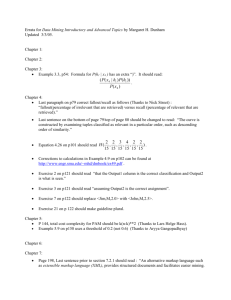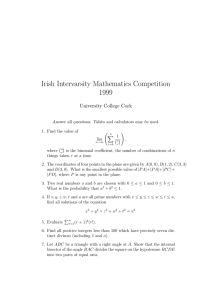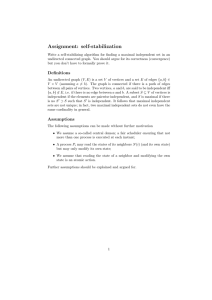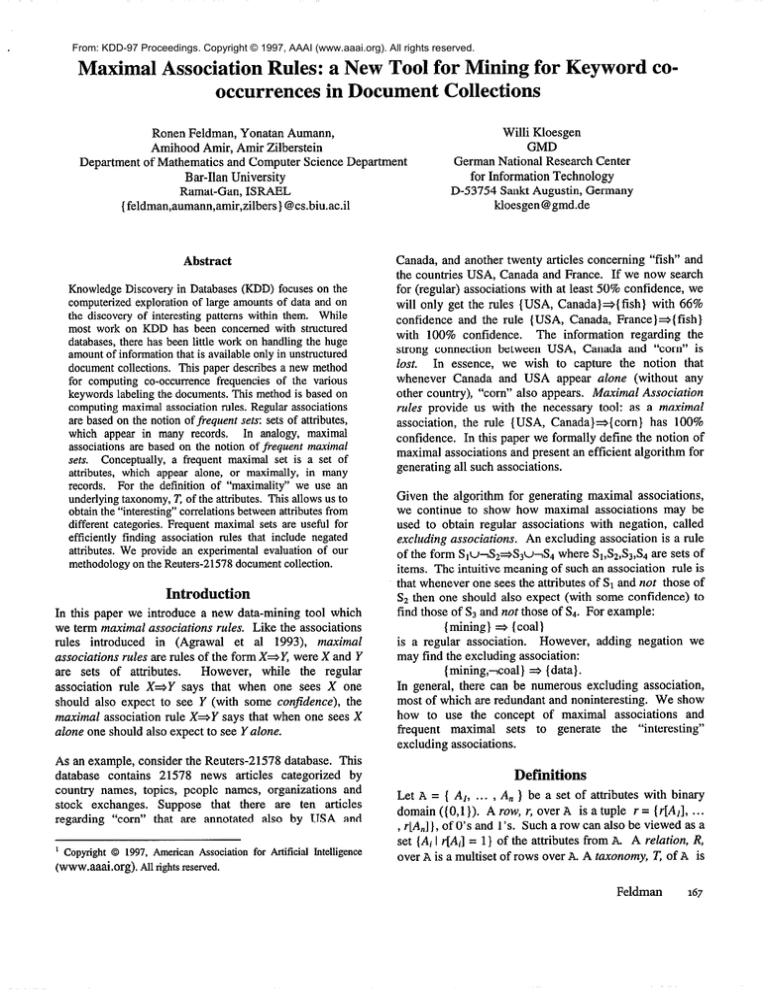
From: KDD-97 Proceedings. Copyright © 1997, AAAI (www.aaai.org). All rights reserved.
Maximai Association Ruies: a New Tooi for Mining for Keyword cooccurrences in Document Collections
Ronen Feldman,Yonatan Aumann,
Amihood Amir, Amir Zilberstein
Departmentof Mathematicsand Computer ScienceDepartment
Bar-Ilan University
Ramat-Gan,ISRAEL
{ feldman,aumann,amir,zilbers}
@cs.biu.ac.il
Abstract
Knowledge Discovery in Databases(KDD) focuses on the
computerized exploration of large amounts of data and on
the discovery of interesting patterns within them. While
most work on KDD has been concerned with structured
databases,there has been little work on handling the huge
amount of information that is available only in unstructured
document collections. This paper describes a new method
A:..c---..---I-- -4 AL- various
for cotiiptirmg CO-OCCUtTetiCe
rreyuencm 01 tnr. ..-2-..keywords labeling the documents.This method is based on
computing maximal associationrules. Regular associations
are based on the notion offrequent sets: sets of attributes,
which appear in many records. In analogy, maximal
associations are based on the notion of frequent maximal
sets. Conceptually, a frequent maximal set is a set of
attributes, which appear alone, or maximally, in many
records. For the definition of “maximality” we use an
underlying taxonomy, T, of the attributes. This allows us to
obtain the “interesting” correlations between attributes from
different categories. Frequent maximal sets are useful for
..cG..:..,+l..lllluurl;
Jz..rl:,,. abci”Llall”
,..,A”*:,, ‘I .LU‘
.. ..a1
:-,.l..Aa IE~cx~”
rra.Tr.*.wl
GjlllLPallly
GBA.“*
ULLILIIILI”U~
attributes. We provide an experimental evaluation of our
methodology on the Reuters-21578document collection.
Introduction
In this paper we introduce a new data-mining tool which
we term maximal associations rules. Like the associations
rules introduced in (Agrawal et al 1993), maximal
associations rules are rules of the form X-Y, were X and Y
are sets of attributes. However, while the regular
association rule X-Y says that when one sees X one
should also expect to see Y (with some conj?dence), the
maximal associationrule X*Y says that when one seesX
alone one should also expect to see Y alone.
As an example,consider the Reuters-21578database.This
database contains 21578 news articles categorized by
country names, topics, people names, organizations and
stock exchanges. Suppose that there are ten articles
regarding “corn” that are annotated also by USA and
Willi Kloesgen
GMD
GermanNational ResearchCenter
for Information Technology
D-53754 Sankt Augustin, Germany
kloesgen@gmd.de
Canada,and another twenty articles concerning “fish” and
the countries USA, Canada and France. If we now search
for (regular) associationswith at least 50% confidence, we
will only get the rules {USA, Canada}*{fish} with 66%
confidence and the rule {USA, Canada, France]*{fish}
with 100% confidence. The information regarding the
strong connection between USA, Canada and “corn” is
lost. In essence, we wish to capture the notion that
whnn,x,car
““LIUIIU”“I
Pnnnrln
~UIICLUU
nnrl
LU,”
TTCA
VU‘S
n,-,n~c,r
uyy”Lu
nlnno
U”“,ll
(,w;thm,t
\..‘
L”“U.
anv.J
L.‘
other country), “corn” also appears. Maximal Association
rules provide us with the necessary tool: as a maximal
association,the rule {USA, Canada}=,{corn} has 100%
confidence. In this paper we formally define the notion of
maximal associationsand presentan efficient algorithm for
generatingall such associations.
Given the algorithm for generatingmaximal associations,
we continue to show how maximal associationsmay be
used to obtain regular associationswith negation, called
excluding ass0ciiiikwi,i. An excluding association is a riile
of the form SIu-Sz~S3u~S4 where S1,S2,S3&are sets of
items. The intuitive meaningof such an association rule is
that wheneverone seesthe attributesof S1and not those of
S2 then one should also expect (with some confidence) to
find those of S3and not those of &. For example:
{mining} * {coal}
is a regular association. However, adding negation we
may find the excluding association:
{ mining,+oal} + (data}.
In general, there can be numerous excluding association,
most of which are redundantand noninteresting. We show
how to use the concept of maximal associations and
frequent maximal sets to generate the “interesting”
excluding associations.
Definitions
Let A = { AI, . . . , A,, } be a set of attributes with binary
domain ({ 0,l }). A row, r, over A is a tuple r = (r[AJ, . . .
r[A,] }, of O’s and 1’s. Such a row can also be viewed as a
Let (Ai I r[Ai] = 1) of the attributes from A. A relation, R,
over A is a muitiset of rows over A. A taxonomy, T, of A is
Feldman
167
a collection of subsets T=(T,.....T,'r.
\_,,...,_
n,, TCA
-,=cover A. Each Ti is called a category.
_, which
..___ -__ tnrrether
_- D- -----
We first define regular association, as described by
(Agrawal et al., 1993). For a given row, r, and set of items
X, we say that r supports X if Xcr. The support of X in a
relation R, denoted by Q(X), is the number of rows rER
which support X. An association rule is a rule of the form
X+Y, where X and Y are attribute sets. The support of the
association is the support of XuY, and the confidence of
the associationis sR(XuY)/sR(X).
Maximal association rules are defined in analogy. A
taxonomy pair is a pair X:L, where X is a set of items and L
is a category such that X@. We call L the boundary of the
pair. For row r and taxonomy pair X:L we say that X:L is
maximal in r, if mL=X. The support of X:L in a relation
R, denoted by msR(X:L), is the number of rows rER such
that X:L is maximal in r. Given a row r and taxonomy T,
the set of all maximal taxonomy pairs of r is denoted
v(r).
We can extend these notions to sets of taxonomy pairs. Let
v=(x]:LI ,. . ..,Xk:Lk} be a set of taxonomy pairs. We call V
a taxonomy set. For V as above we also write V=X:L,
where X=(X,,...&) is the sequence of item sets and
L=(L1,...,Lk) are the boundaries. For row r and taxonomy
set V, we say that V is maximal in r, if Xi:Li is maximal in r
for all i. The support of V in a relation R, denoted by
ms&‘), is the number of rows rE R such that V is maximal
in r.
A va”-“1,,“ll”
mn~imnl
-a
nrcnrintinn
IIYYYI,.L*IIV,I
nrlo ;c
sn evnroccinn
vAp”.mL”rl
,,m”c.
I., -11
nf
“I
tha
LLlU fnrm
l”l,,,
where V and W are maximal sets. The support of
the association is msR(VuW), and the confidence of the
association is msR(VuW)/ms,( V).
VaW,
We search for associations where the support is above
some user-defined threshold, which we call the minimum
support (denoted by a), and whose confidence is above
another user-defined threshold, which we call the minimum
confidence (denoted by y). An attribute set with at least the
minimum support is a frequent set. A taxonomy set V is
caiied a maximal frequent set if msR(V) 2 0.
Example:
Consider the relation R consisting of the following rows:
(Canada, Iran, USA, crude, ship} x 2
{USA, earn)
(USA, jobs, cpi) x 2
{USA, earn, cpi)
(Canada, sugar, tea)
(Canada, USA, trade, acq) x 2
{Canada, USA, earn)
168
KDD-97
We will use a simple taxonomy that contains 2 categories:
“countries” and “topics” (i.e., T = (countries, topics)):
Given that CJ= 2, and yT 0.5, we have the following
frequent maximal sets with respect to T = (countries,
topics). The value of ms(V) is written next to each frequent
maximal set V.
( (USA): “countries”) 4
( (Canada, Iran, USA) : “countries”) 2
( (Canada, USA) : “countries”) 3
,.+..rla
,II r bI
U”G,
,h:,i
WqJ,
. ~bv..:,..,~~,
‘)
. rvp,uJ
, L
((trade, acq) : “topics”) 2
((Canada, Iran, USA) : “countries” ,(crude, ship) :
“topics”) 2
((USA) : “countries” ,( cpi, jobs) : “topics”) 2
( (Canada, USA) : “countries” ,{ acq, trade) : “topics”) 2
From the above frequent maximal sets we obtain the
following maximal associations:(braces were eliminates to
simplify the notation):
USA : “countries” + jobs,cpi : “topics” (2/0.5)
Canada, Iran, USA : LLcountries”* crude, ship : “topics”
(2/1.0)
Canada,USA : “countries” + acq, trade : “topics” (2/0.66)
Specifying the boundaries in each expression may be
cumbersome. In most cases, for an item set X, we are
interested in all maximal taxonomy pairs in X. Thus, we
adopt the following shorthand notation. Let X be a set of
attributes. For taxonomy T, Xr will denote the taxonomy
set Xr=( (XnL):L I LE T, XnL.#O ). Thus, Xr is the set of
all maximal taxonomy pairs in X When clear from the
context we shorthandX for Xr.
Computing
Frequent Maximal
Sets
We now show how to compute all frequent maximal sets in
a relation R, given a taxonomy T and support threshold 6.
The first step is to transform R into a new relation R’,
which lends itself to a speedy counting of support for
taxonomy pairs. For each rER, we replace r by
rT=((mTJ:Ti
I TiET, XnT#0
). Let R’=(rT I r E R).
Note that the attributes of R’ are taxonomy pairs. The
c 1.
rollowing eiementary ciaim estabiishes the necessary
relation between R and R’.
Claim: Let V=(XI:LI ,...., Xk:Lk), W=( YI:HI ,...,, Yl:Hl), be
sets of taxonomy pairs. V*W is a maximal association
rule in R with support a and confidence /? iff it is a
regular
association with the same support and confidence
in R’.
Thus, it is sufficient to generate the associations is R’.
This we do using any of the existing methods (e.g.
[Agrawal and Srikant, 19941).
Example:
T =( “countries”={ USA, Canada,Iran,. . . . },
“North-America”={ USA, Canada,Mexico},
“topics”={ acq,jobs, cpi, crude, ship} )
R: (Canada,sugar,tea}, (USA, Canada,Iran, trade, acq),
(USA, Canada,France,earn}
Then R’ is:
( (Canada):“countries”,(Canada}:“North-America”, (sugar
,tea}:“topics”},
( (USA,Canada,Iran):“countries”,{ USA,Canada):“NorthAmerica”,{ trade,acq}:“topics”),
( (USA,Canada,France):“countries”,
(USA,Canada):“North-America”, (earn): “topics”)
With support threshold2, the only frequentmaximal set is:
(USA,Canada):“North-America”)
1. To restrict the amount of sets generated we can use
small taxonomies. Our experimentsprove that even with
very small taxonomies we obtain interesting results. The
tradeoff betweenthe size of the taxonomy and the number
of interesting excluding associationsis a matter for future
research.
A maximal associationrule is, by definition, an excluding
association. In order to get only the interesting
associationswe look for maximal associationrules X:L +
Y:L’ where the corresponding regular association rule
set(X)* set(Y) does not hold (where set(x) is the union of
all items in x). Once we have such a rule, we must find
negation parts, S2 and S+ In general there may be many
possible Sz and Sq. In this case we are interested the
minimal Sz, and maximal Sq. However, note that S4 can
only decreaseboth the support and confidence of the rule.
Thus, since we are interested in simple rules with high
confidence,we shall drop S, altogether.
Excluding Associations
Let S=(A&,...&)
be a set of attributes. We denote the
,.
.
.,-!A,)
by 7s. Excluding associationsare
set (-h-A
rules of the form SIuTSz * S3u+ where S&S&
are
disjoint sets. The intuitive meaning of such a rule is that
wheneverone seesthe attributes of St and not those of Sz
then one should also expect (with someconfidence)to find
those of Ss and not those of Sq.
In general, the number of excluding associations that
exceed the support and confidence threshold is much
higher than the number of regular associations(without
negation). This is because each association without
negationcan give rise to many excluding associationswith
exactly the same support and confidenceby simply adding
the negationof irrelevant attributes.
These excluding associationare certainly of no interest. In
order to control the number of excluding associations,we
introduce a redundancy filter that is designed to capture
“interesting” excluding associations. We define a rule
SIU+
a S++
to be interesting if it has the required
support and confidence, but the correspondingassociation
without the negations,Sr + Ss, does not have the required
confidence(it will always have at least the samesupport).
Consider the frequent maximal set X:L, with support a.
Denote S,=set(X). The maximal set X:L correspondsto the
We seek the minimum
negation set: Sp+set(L)-S,).
cardinality set Sz,Sg(set(L)-SJ, for which Sru+ retains
the supporta. To this end, we consider all maximal setsof
the form Z:L where XCZ. We then compute the residue of
each of these maximal sets with regard to X, i.e., we
compute se&Q-set(X). Finally, S2 obtained by computing
the minimal set cover of all these residues.We want Sz to
contain at least one element from each of the residues.In
that way S, covers all possible residues, and eliminates
their supportfrom the support of the current rule.
The set covering problem is NP-Complete and hence we
must use a polynomial approximation. We will use a
greedy covering algorithm to find the minimal cover of all
residues.We will compute for each of the elementsin the
residuesthe number of residue in which they appear.We
then select the element that appearsin the highest number
of residuesand we delete all the residuescoveredby it. We
then update the residue-count for each of the remaining
elements and start the process again. The process will
terminate when all residues were deleted. The elements
that have been accumulatedwill be the membersof the set
s2.
Even after introducing this redundancyfilter, generatingall
interesting excluding associationis a hard problem. Here
we show that maximal associationrules, introduced in this
paper, give a partial solution to the problem of finding this
problem. Using frequent maximal sets, we shall generate
all the interesting excluding association with negations
within the taxonomy. I.e., we generatethe rules Stu+
j Ssu-& where the attributes of Sz (S4) are in the same
categoriesas those St (res. Ss). The algorithm we present
needsto generateall maximal sets,even those with support
The Document Explorer system using the Reuters-21578
collection found around 30 excluding associations.For
instance,the associationrule (south-africa, usa)+{ acq),
when seen as a regular association, is supported by 9
documents and has 34% confidence. When we view
(south-africa, usa)+(acq) as a maximal associationrule
we still have the same support and the confidence of the
rule increasesto 50%. Using the algorithm in Figure 1 we
found that the contentsof SZis (argentina,kenya, uk, Zaire
Feldman
169
1. In other words the excluding association rule
{south-africa, usa, T argentina, 7 kenya, T uk, 7 Zaire
}=+{ acq) has support 9 and confidence50%.
Our algorithm finds the minimal S, such that the excluding
association will have exactly the same support and
confidence as the corresponding maximal associations.
However, we may delete some of the elementsof Sz if their
removal will only change the confidence by a small
amount. Such excluding associations will be shorter and
hence more meaningful. For example, starting from the
excluding associationof
{italy, usa, 7 west-germany, 7 japan, 7 iran, 7
fiance }a{ acq}
which has support 10 and confidence 71%, ommiting
japan, iran, and fiance from Sz, we obtain the excluding
association
{ italy, usa, 7 west-germany}*{ acq)
with support 10 and confidence 59% (recall that the
association (italy, usa)+(acq) has support 10 and
confidence 25%). Document Explorer uses a heuristic
algorithm for finding such reductions.
Conclusions
We presenteda new form of co-occurrence computation
suitable for structureddatabasesand in particular useful for
document collections. This new form is based on the
notion of maximal sets. Maximal sets are defined with
respect to a taxonomy. Roughly speaking a frequent
maximal set is a set of attributes that in many rows form
the largest subset in given categories. The taxonomy is
provided by the user. A more complex taxonomy will give
rise to a larger number of frequent maximal sets and, as a
result, a larger number of maximal associationrules.
Frequent maximal sets are useful for a variety of tasks.
Foremost, they provide means to capture inference rules
otherwise lost using the regular associations. In particular,
maximal associationrules expressthe associationbetween
subsets of attributes appearing “alone”. Maximal
associationsalso help to reduce the number of generated
associationsand get only associationsthat are supportedby
the structure of the databaseor the document collection. In
addition, frequent maximal sets are useful to infer
interesting excluding associations, a task that would be
very difficult without using frequent maximal sets. Finally,
we can use these sets for dynamic browsing of document
collections. Here, frequent maximal sets are used here to
capture the exact reiationship between entities in tbe
collection.
Future work will include improving the usage of frequent
maximal sets to find all possible excluding associations,
and the generation of frequent maximal sets without the
need of user-provided taxonomies. The taxonomy
170
KDD-97
information will be directly inferred from the document
collection.
Acknowledgements
This research was supported by grant # 8615 from the
Israeli Ministry of Sciences,and by a GIF grant I-429-096.
References
Agrawal R., Mannila H., Srikant R., Toivonen H., and
Verkamo I. 1996. Fast Discovery of Association Rules. In
Advances in Knowledge Discovery and Data Mining, Eds.
U. Fayyad, G. Piatetsky-Shapiro, P. Smyth, and R.
Uthurusamy, pages307-328,AAAI Press.
Agrawal R. and Srikant R. 1995. “Mining Sequential
Patterns“, Proc. of the Int? Conference on Data
Engineering (ICDE), Taipei, Taiwan, March 1995.
Agrawal A., Imielinski T., and Swami A. 1993. Mining
associationrules between sets of items in large databases.
In Proc. of the ACM SIGMOD Conference on Management
of Data, pages207-216.
Amir A., Aumann Y., Feldman R., and Katz 0. 1997. Trie
Based Algorithms for Discovering Frequent Sets in
Databases. Technical Report, Department of Computer
Science,Bar-Ilan University, Israel.
Feldman R., and Hirsh H. 1997. Mining Associations in
Text in the Presence of Background Knowledge. In
Proceedings of the 2nd International Conference on
Knowledge Discovery (KDD-96), Portland, Aug 1996.
Feldman R., Dagan I., and Kloesgen W. 1996. Efficient
Algorithms for Mining and Manipulating Associations in
Texts. In Proceedings of EMCSR96, Vienna, Austria, April
1996.
Feldman R., Amir A., Aumann Y., Zilberstein A., and
Hirsh H. 1997. “Incremental Algorithms for Association
Generation”. In Proceedings of the 1” Pacific Asia
Conference on Knowledge Discovery and Data Mining
(PAKDD97), Singapore,1997.
Feldman R. and Dagan I. 1995. KDT - knowledge
discovery in texts. In Proceedings of the First
International
Conference on Knowledge Discovery (KDD-
95), August 1995.
Lewis D. 1997. “The Reuters-21578, Distribution 1.0”
ht$rllWWw,research.att,
COIZZ l-il$WiShUteE21578
Mannila H. and Toivonen H. 1996. Multiple uses of
frequent sets and condensed representations- Extended
Abstract. In Proceedings of the 2nd International
Conference on Knowledge Discovery & Data Mining
(KDD-96), Portland, Aug 1996.


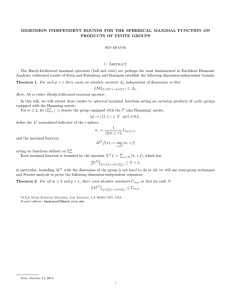
![Mathematics 321 2008–09 Exercises 5 [Due Friday January 30th.]](http://s2.studylib.net/store/data/010730637_1-605d82659e8138195d07d944efcb6d99-300x300.png)

